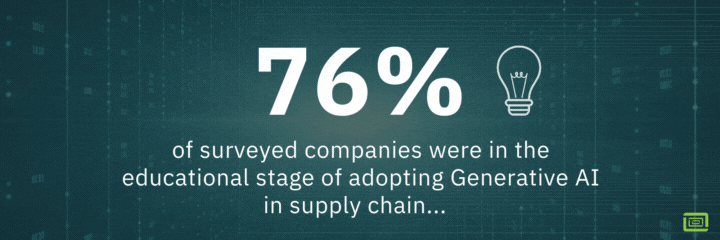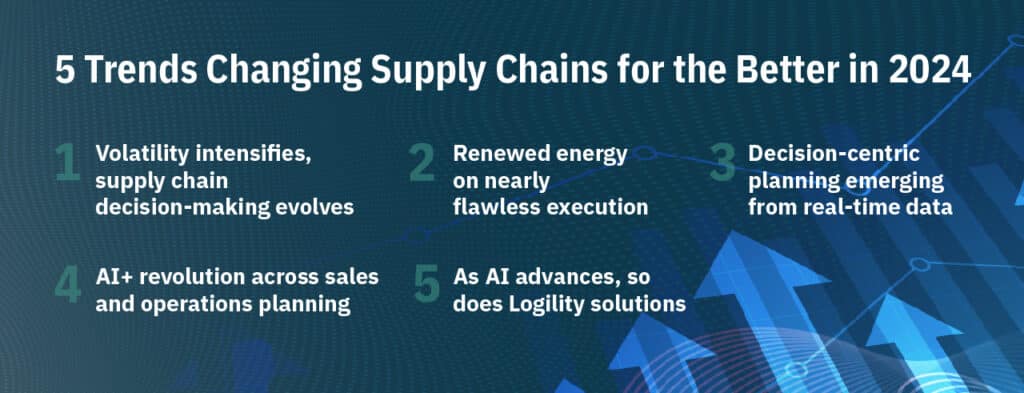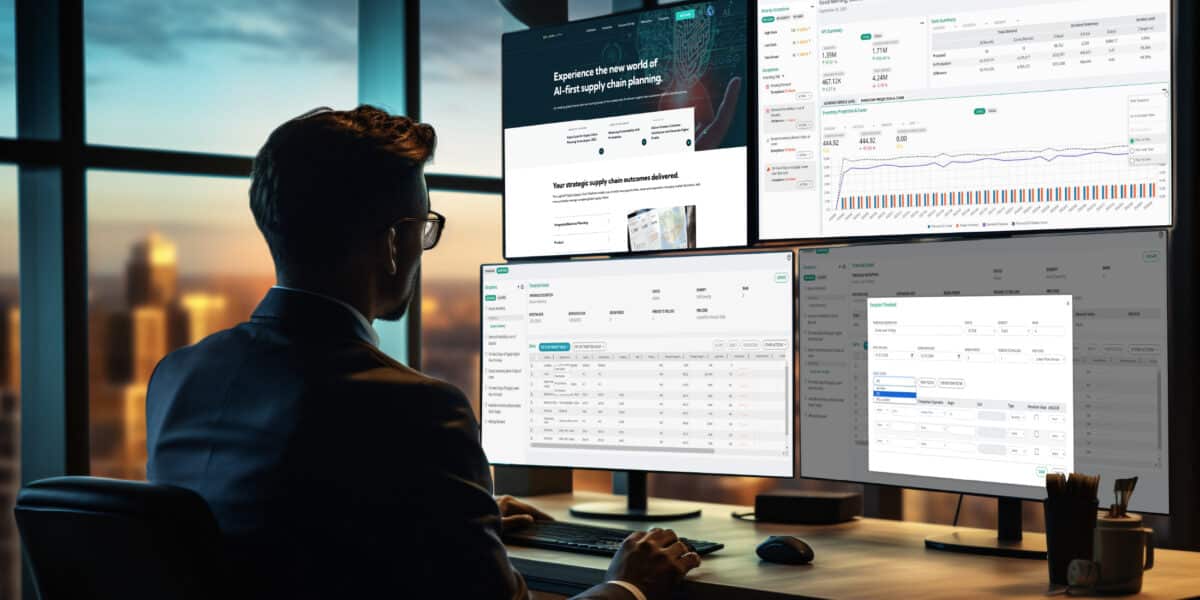
What defines a high-performing supply chain? Depending on who you ask, the answer can be anything from low costs and efficiency to a delicate balance between profitability and customer service. However, this year promises a significant paradigm shift where traditional performance metrics are replaced by technology-driven frameworks, as recent breakthroughs with Generative AI in supply chains have demonstrated.
Enter our list of supply chain trends for 2024. Beyond making mere predictions, our executives compiled trends based on analyst insights and their observations of real-world supply chain operations worldwide. They unravel the role of data and AI in building supply chain agility and resiliency as imperatives that will shape supply chain success for today and tomorrow.
Volatility intensifies, supply chain decision-making evolves
Trend #1: This year will be volatile – possibly more than 2023. In response, supply leaders must acquire better decision-making support, such as AI-first solutions.

As the volatility, uncertainty, complexity, and ambiguity of the economy and markets escalate, running a resilient supply chain becomes vital. Gartner suggests that this shift from accuracy to resiliency in supply chain planning is necessary to immediately see the effects of disruption and respond to the dynamic nature of the current business environment.
Yet, despite the buzz, common usage of AI and digital twins remains limited. A poll during one of our recent webinars on AI-first supply chain planning showed that 76% of surveyed companies were in the educational stage of adopting Generative AI in supply chain. Meanwhile, 31% said they were either developing proposals to begin or currently undergoing a pilot phase, testing the waters of AI integration into their supply chains.
According to Allan Dow, President of Logility and CEO and President of American Software, “As 2023 marked a year of potential and speculation around AI, the year ahead beckons a practical application of its capabilities. As manufacturers intentionally design their supply chain flows, AI becomes a key ally in synthesizing complex data sets, managing higher numbers of SKUs, and navigating intricate operations – while meeting rising expectations for faster fulfillment and customer satisfaction.”
A significant challenge lies in the need for leaders to be educated on effectively leveraging AI. A structured approach to supply chain AI is the answer to a smooth transition. Companies must define objectives, acquire the right tools and technology, prepare the data infrastructure, implement AI models, and continuously improve the system.
Renewed energy on nearly flawless execution
Trend #2: Early adopters of end-to-end supply chain planning will showcase the positive impact of proactive efforts.
Supply chains are also witnessing a resurgence in emphasis on near-flawless execution. Pioneers in adopting comprehensive end-to-end planning are poised for substantial gains. Having invested time in building robust planning frameworks, early adopters will reap rich rewards as a clear divide surfaces in analytics and showcases the impact of end-to-end planning implementation.
Scott Abbate, Senior Vice President of the Center of Excellence at Logility, predicts, “Organizations that have embraced this strategic approach will enjoy incremental sales, market share growth, and best-in-class on-time, in-full service. Their success extends to the highest levels of customer satisfaction, fostering unparalleled retention and expansion, and their data will underscore the stark difference in performance between those with end-to-end planning and those without.”
A crucial link between best-in-class end-to-end planning and impeccable execution is also arising. Organizations rooted in a culture of constant firefighting during execution inevitably lag behind the competition. In contrast, those with a meticulous planning culture can execute at a superior level, reducing the need for reactive measures.
“…shift from accuracy to resiliency in planning using Digital Twin of the supply chain with powerful scenario planning capabilities on top… and immediately see the effects of supply chain disruption” – Eric Hageman, Senior Director EMEA, Logility
Fortunately, the window of opportunity is still open for organizations aspiring to adopt end-to-end planning. Even those in the early stages of adoption can leverage its strategic advantages, making 2024 a pivotal year for transforming supply chain execution.
Decision-centric planning emerging from real-time data
Trend #3: Supply chain perspectives will shift with real-time, data-driven insights – guiding more accurate predictions in the future.
The spotlight on traditional, cyclical supply chain planning processes reveals a growing skepticism toward static forecasts and long-term projections. Stepping into prominence is decision-centric planning, marking a profound change in perspective. The focus shifts from predicting the future to actively shaping it through informed, real-time decision-making.
“Modern technology is the key ‘‘unlocker.’’ Cloud-based platforms act as aggregators, pulling data from every corner of the supply chain, while AI and machine learning models weave it into actionable insights.” – Lachelle Buchanan, Vice President, Logility
Our experts cite examples such as a sudden spike in demand for a specific product – a scenario that might have triggered emergency measures in the past. Now, decision-centric planning analyzes supply availability, production capacity, and cost implications, offering nuanced responses, including production adjustments to avert costly excesses and sustainability risks.
As technology advances, decision-centric planning is poised to become the norm, replacing the slow rhythm of cyclical forecasts with a nimble, data-driven ballet of continuous adaptation. The rewards for those embracing this shift are evident: a supply chain resilient in the face of change, thriving in uncertainty and delivering unparalleled value to customers.
AI revolution across sales and operations planning
Trend #4: As processes drastically change, demand planners will have more time to focus on strategic transformations and the smooth delivery of intelligent sales and operations planning (S&OP).
The fusion of generative AI and narrow AI is set to revolutionize how knowledge workers engage with inventory management, S&OP, and supply planning. Established processes, forms, and functions will cease to be rigid constructs, evolving into fluid and instantly adaptable frameworks that respond readily to emergent situations. In addition, data formats can become universally accessible, empowering decision-makers with real-time insights presented in users’ natural language.
The integration of generative AI will usher in a profound impact on demand planners. This shift provides more time and cognitive space for strategic transformation and seamless orchestration of intelligent S&OP. With supply chain management inherently involving a continuous chain of decisions, the availability of generative AI can streamline the preparation for meetings, offer invaluable support with significantly less effort, reduce latency, and elevate decision-making accuracy.
“The best way to shorten the time to decision is to have the organization work parallel instead of sequential to quicker come to the optimal plan and use optimization to get to the best possible solution first before attending [meetings] to remaining problem cases.” – Markus Malinen, Vice President EMEA, Logility
Organizations at the forefront of integrating generative AI into their operations will not only be able to navigate the complexities of supply chain management more efficiently but position themselves as leaders in harnessing the transformative power of advanced artificial intelligence.
As AI advances, so do Logility solutions
Trend #5: Each new AI advancement presents a unique opportunity to deliver supply chain planning capabilities that tackle today’s challenges and prepare for tomorrow’s demands.
Increasingly, AI is being developed to help companies face turbulent economic conditions marked by unpredictable consumer spending patterns and the threat of recession and inflation. The same holds for the supply chain organization. As consumers allocate more resources to basic survival needs, planners can use technology to detect and respond to shifts in purchasing behavior, avoiding inventory excess or shortages.
Logility recognizes this opportunity and leverages the best of what AI offers in its DemandAI+ solution. Designed to detect market events influencing demand automatically, the solution plays a pivotal role in equipping companies with tools to tackle dynamic market conditions.
Embedded with GenAI, DemandAI+ ensures that supply chain organizations can respond effectively to sudden changes in demand by swiftly delivering decision-quality data and retaining valuable demand knowledge for future planners. This innovative solution of generative AI in supply chains democratizes intelligence, enabling broader and more meaningful participation in decisions, empowering companies to adapt to inflection points and optimize their strategies for success.
Over the next twelve months, Logility is actively making generative AI accessible to the supply chain community, moving beyond buzzwords to tangible implementation. The focus is not on returning to a ‘normal’ state but on leapfrogging beyond it with AI-powered visibility and responsiveness.
Don’t just weather the storm but emerge stronger and more resilient through strategy and data-driven decision-making. Explore more from our experts about trends, predictions in any of our upcoming webinars, or get in touch here.



